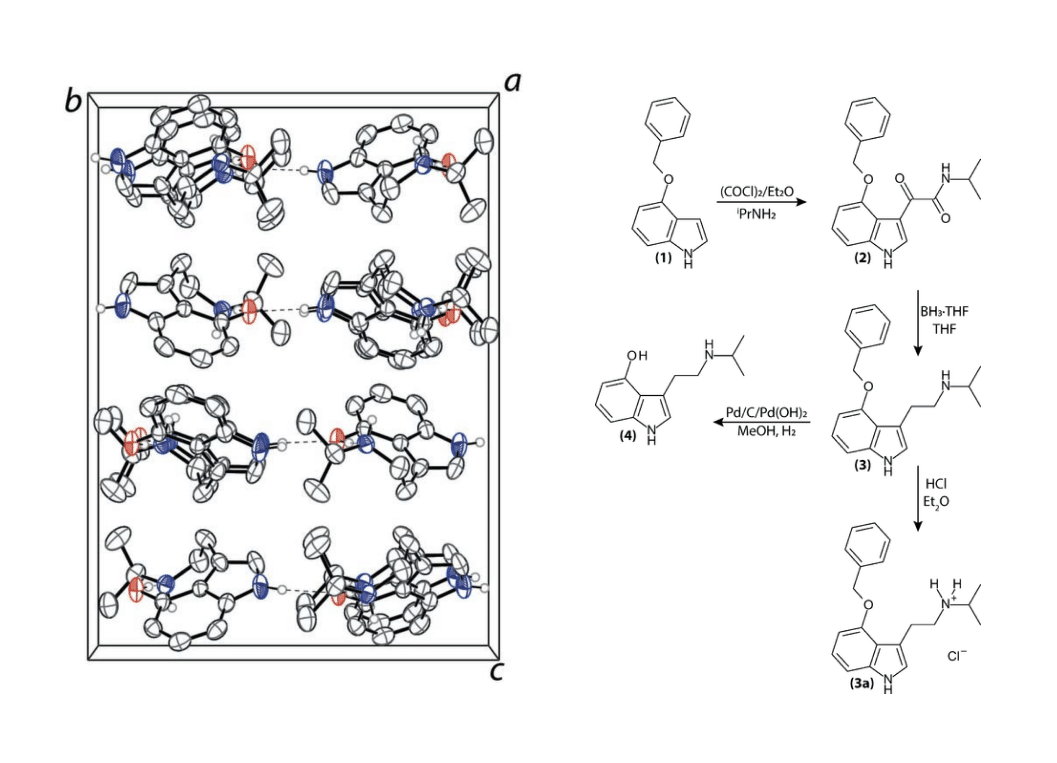
CaaMTech, in collaboration with scientists from the Manke Lab at UMass Dartmouth, recently published its synthesis and structural characterization of 4-HO-NiPT and several of its precursors. The research lays the groundwork for the pharmacological study of monoalkyl tryptamine analogues of relatively well-characterized dialkyl tryptamines such as psilocybin and psilocin. Perhaps more importantly, the study provides the first crystallographic characterization of an active metabolite of 4-HO-DiPT, a drug being actively developed as a therapeutic. “Synthesis and structure of 4-hydroxy-N-isopropyltryptamine (4-HO-NiPT) and its precursors” was published in the American Chemical Society’s journal, Acta Crystallographica, Section E.
4-HO-NiPT (more formally, 4-hydroxy-N-isopropyl-tryptamine) is a monoalkyl tryptamine: structurally, it has only one alkyl group on the ethanolamine part of the molecule. Psilocybin and psilocin, two of the most well-known tryptamines that occur naturally in “magic” mushrooms, are dialkyl tryptamines having two alkyl groups on the ethanolamine nitrogen. Magic mushrooms naturally contain monoalkyl tryptamines, such as baeocystin and norpsilocin. But these compounds and other monoalykl tryptamines have garnered far less attention than their dialkyl analogues. As a result, and despite their presence in mushrooms being legally sold in jurisdictions such as Oregon, the pharmacology of monoalkyl tryptamines is poorly understood.
“It’s a whole class of molecules that virtually no one has studied ,” lamented Dr. Andrew Chadeayne, CaaMTech CEO. “We know that monoalkyl tryptamines are potent serotonergic drugs; but they’ve been completely overlooked relative to compounds like psilocybin, psilocin, DMT, and others, which are all dialkyl tryptamines.”Understanding the pharmacology of monoalkyl tryptamines is also critical to evaluating pharmaceuticals that are currently in early stage of development. For example, 4-HO-NiPT has been demonstrated to be a metabolite of 4-HO-DiPT (Malaca et al., 2022). 4-HO-DiPT (more formally, 4-hydroxy-N,N-diisopropyltryptamine and informally, diprocin) is itself the targeted active metabolite of prodrugs that are commercially developed as therapeutics, such as 4-glutarato-DiPT. Patients dosed with 4-glutarato-DiPT and other 4-HO-DiPT prodrugs will be subject to both the pharmacological effects of 4-HO-DiPT and subsequently 4-HO-NiPT. Due to the lack of published research in this critical area, CaaMTech continues its pioneering investigation of monoalkyl tryptamines such as 4-HO-NiPT with a commitment to expediently publishing the results in the peer reviewed scientific literature.